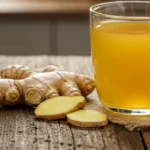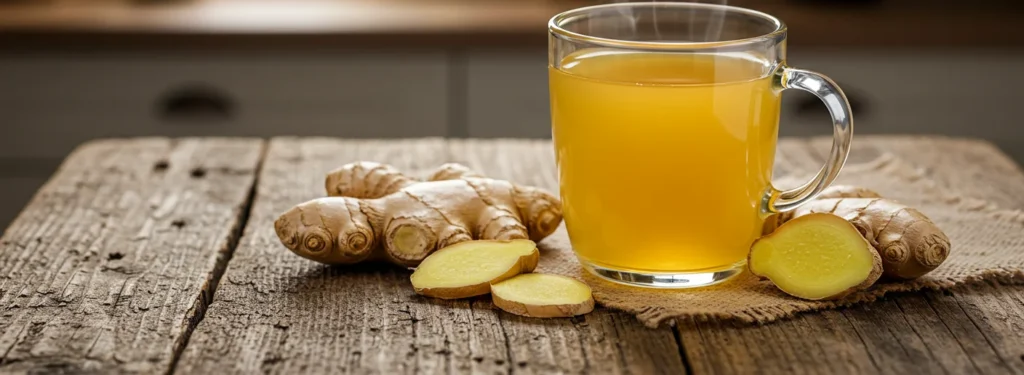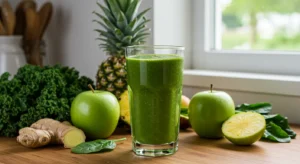The Remedy I Always Turn To
A few years back, I found myself curled up in the passenger seat on a winding drive through the Smoky Mountains, regretting every twist of the road. My stomach was in full revolt. Thankfully, I remembered something my grandmother used to say: “Ginger’s the root that knows what your belly needs.” I dug into my tote, pulled out a thermos of freshly brewed ginger tea I had made that morning, and within twenty minutes, the queasiness began to ease.
That moment reminded me how powerful this humble root can be. Ginger tea for nausea isn’t just a trend or a folk tale—it’s a time-tested remedy I’ve turned to for everything from road trip upsets to queasy flu days. It’s simple, warming, and surprisingly fast-acting. Around here in Asheville, my pantry always holds a fresh root, and if you drop by, I’ll gladly steep you a mug—especially if you’ve got a sour stomach or need a little grounding.
I’ve always believed in healing from the kitchen first, which is why you’ll find recipes like my Gut Healing bone broth or Chia Seed Water.

Why Ginger Tea for Nausea Is So Effective
What makes ginger tea for nausea such a trusted option isn’t just tradition—it’s the science behind the root. Ginger contains bioactive compounds like gingerols and shogaols that interact with receptors in your digestive system and central nervous system. These compounds help relax the stomach, reduce inflammation, and calm the muscular contractions that lead to vomiting.
Unlike over-the-counter medications that can cause drowsiness, ginger tea is gentle, natural, and doesn’t interrupt your day. Plus, the warmth of the tea itself soothes the belly while keeping you hydrated—a win-win during those nauseating moments.
Whether you’re battling motion sickness, recovering from a virus, or simply dealing with a fussy stomach, ginger tea for nausea is one of nature’s most reliable allies.
Why Ginger Tea Works for Nausea
Ginger’s Powerful Compounds Explained
The reason ginger tea for nausea works so effectively comes down to its active components—gingerols and shogaols. These compounds target receptors in the digestive tract and brain that are responsible for triggering nausea. They help by reducing inflammation, slowing down stomach contractions, and promoting smoother digestion overall. Think of it like this: your stomach wants calm, not chaos—and that’s exactly what ginger delivers.
Research backs this up. Studies published in medical journals have shown that ginger can be just as effective as anti-nausea medications like dimenhydrinate and even some used in chemotherapy settings. The beauty of ginger tea lies in its simplicity. No chemicals. No side effects. Just a steeped root doing what nature designed it to do.
To get the most out of your cup, make sure you’re using fresh ginger root and letting it simmer long enough to extract its full potency. I usually recommend at least 10 minutes of steeping time to really pull those anti-nausea benefits into the brew.
When Ginger Tea Is Most Helpful
Ginger tea isn’t just a one-note remedy. It can help in many situations where nausea creeps in unexpectedly. For example:
- Morning sickness: Many pregnant women find relief with a small cup of ginger tea in the morning, though always in moderation.
- Motion sickness: Whether it’s a car ride or boat trip, a thermos of ginger tea is my secret weapon.
- Indigestion: If you’ve overindulged, this tea will settle your stomach quickly.
- Stomach bugs: When hydration and comfort are key, ginger tea becomes a healing ally.
- After meals: A small cup can aid digestion and prevent that bloated, uneasy feeling.
So whether you’re looking for daily digestive support or a reliable way to combat occasional nausea, ginger tea has your back—and your belly.
How to Make Ginger Tea for Nausea (With Variations)
Simple Fresh Ginger Tea Recipe
Making ginger tea for nausea at home is quick, affordable, and more effective than store-bought blends. I always recommend using fresh ginger root over powdered or bagged versions for the strongest results.
Here’s my go-to recipe:
Ingredients
- 1 ½ cups water
- 1–2 inches of fresh ginger root, peeled and thinly sliced
- Optional: raw honey, lemon juice, or cinnamon
Instructions
- Bring water to a gentle boil in a saucepan.
- Add sliced ginger and reduce to a simmer.
- Let it steep for 10–15 minutes, uncovered.
- Strain into your favorite mug.
- Add honey or lemon, if desired.

Sip slowly while it’s still warm. You can drink up to three cups a day, especially if you’re using ginger tea for nausea related to digestion or motion sickness.
For an extra boost during cold or flu season, I often mix in a spoonful of raw honey and a splash of lemon. Both enhance the flavor and add soothing, anti-inflammatory benefits. You can see how blend these flavors in ginger honey cold remedy.
Tasty Variations to Support Your Stomach
Ginger tea doesn’t have to be plain. Here are a few of my favorite variations that support digestion and fight nausea without sacrificing flavor:
- Ginger-mint tea: Add a few fresh mint leaves for a cooling, calming effect on the gut.
- Ginger-lemon tea: A squeeze of lemon adds vitamin C and brightens the flavor.
- Cinnamon-ginger blend: Add a cinnamon stick during simmering for a comforting and anti-inflammatory kick.
- Ginger-turmeric tea: Combine anti-nausea power with anti-inflammatory benefits by adding a pinch of turmeric.
If you need something gentler or caffeine-free, check out best herbal teas for sensitive stomachs. But for all-around effectiveness, ginger tea for nausea is still my first line of defense.
To store extra tea, pour it into a mason jar and refrigerate for up to 3 days. Just reheat gently—don’t microwave it if you want to keep the nutrients intact.
Looking to switch up your ginger tea routine? My ginger switchel is a tangy, probiotic-rich option for nausea and hydration. You might also enjoy my refreshing turmeric ginger lemonade—great for inflammation and gut health.
Best Teas for Nausea (Besides Ginger) and Warnings
How Ginger Tea for Nausea Compares to Other Herbal Teas
While there are several herbal teas that help with upset stomachs, few match the consistent results of ginger tea for nausea. Its unique ability to calm the digestive tract, reduce inflammation, and block nausea signals in the brain puts it in a category of its own.
Still, other teas can be helpful depending on the cause of your symptoms:
- Peppermint tea helps with indigestion and bloating but may worsen acid reflux.
- Chamomile tea is gentle and calming, ideal for nervous stomachs.
- Fennel tea reduces gas and cramping, especially post-meal.
Despite these options, I always go back to ginger tea for nausea because of its fast-acting and full-body approach. It’s especially helpful when you’re not sure what’s causing the queasiness—whether it’s motion, hormones, or something you ate.
When to Avoid Ginger Tea for Nausea
As wonderful as it is, ginger tea for nausea isn’t right for everyone. Here are a few times to be cautious:
- Pregnancy: While safe in small amounts, always check with your doctor.
- Blood-thinning medications: Ginger may enhance the effects and increase bleeding risk.
- Gallstones or acid reflux: Ginger can stimulate bile production, which may worsen symptoms.
If you’re unsure, start with a small amount and monitor how your body responds. In most cases, sipping ginger tea for nausea offers relief without side effects—but it’s smart to know your own limits.
I always recommend starting with fresh, simmered tea like we covered in Part 3 to get the strongest benefits.
If you’re looking to rotate your herbal routine, I also love brewing chrysanthemum tea with goji berries—it’s cooling and antioxidant-rich. For a nutrient-dense boost to your skin and digestion, my retinol carrot salad pairs beautifully with herbal teas.
Do ginger tea help with nausea?
Yes, ginger tea absolutely helps with nausea. It contains natural compounds like gingerol and shogaol that calm your stomach, reduce inflammation, and ease muscle contractions in the digestive tract. Many people find that sipping warm ginger tea for nausea brings fast relief—whether it’s caused by motion sickness, overeating, or illness.
When not to drink ginger tea?
You should avoid ginger tea if you’re taking blood thinners, preparing for surgery, or have gallbladder issues. Ginger can increase bile production and may interfere with some medications. Also, people with acid reflux might find it irritating. If you’re pregnant or breastfeeding, consult your doctor before regularly using ginger tea for nausea.
Does ginger really settle your stomach?
Yes, ginger naturally settles the stomach. It relaxes the digestive muscles, improves circulation, and helps your body expel gas and ease bloating. That’s why ginger tea for nausea has been used for centuries in folk medicine—and is still backed by modern research today.
Which tea is best for nausea?
Ginger tea is often considered the best tea for nausea due to its strong antiemetic (anti-vomiting) properties. However, peppermint, chamomile, and fennel teas can also help depending on the cause. For fast-acting and reliable results, most people turn to ginger tea for nausea as their first choice.
Conclusion
If there’s one remedy I always keep within arm’s reach, it’s a jar of ginger and a kettle on standby. Whether you’re battling motion sickness, queasy from a virus, or just feeling a bit off after a heavy meal, ginger tea for nausea delivers reliable, gentle relief with every sip.
What makes it so powerful isn’t just its science-backed ability to soothe the gut—it’s the comfort it brings. That warm mug in your hands, the aroma of steeped ginger, the way your stomach slowly unclenches—it’s healing in every sense of the word.
Try brewing it fresh, adding your own twists like lemon or mint, and always listen to your body. From my kitchen to yours, I hope this simple tea becomes one of your favorite go-to remedies. And if you’re ever in my neck of the woods, I’ll put the kettle on.
For more herbal wisdom, remedies, and recipes discover our drinks page.
Print
Ginger Tea for Nausea: Simple Natural Relief That Works Fast
- Prep Time: 5 minutes
- Cook Time: 15 minutes
- Total Time: 20 minutes
- Yield: 1 cup 1x
- Category: Herbal Remedy
- Method: Stovetop
- Cuisine: Natural
- Diet: Vegan
Description
This simple ginger tea for nausea is a warming, herbal remedy that helps settle your stomach naturally.
Ingredients
1 ½ cups water
1–2 inches fresh ginger root, peeled and sliced
Optional: 1 tsp raw honey
Optional: ½ lemon, juiced
Optional: 1 cinnamon stick or 3 fresh mint leaves
Instructions
1. Bring water to a boil in a small pot.
2. Add sliced ginger and reduce heat to simmer.
3. Simmer for 10–15 minutes uncovered.
4. Strain into a mug and add honey or lemon if desired.
5. Sip slowly and enjoy.
Notes
Use fresh ginger for best potency.
Drink up to 3 cups daily as needed.
Refrigerate leftovers in a jar for up to 3 days.
Reheat gently—avoid microwaving.
Pair with a light snack if drinking on an empty stomach.
Nutrition
- Serving Size: 1 cup
- Calories: 10
- Sugar: 0g
- Sodium: 5mg
- Fat: 0g
- Saturated Fat: 0g
- Unsaturated Fat: 0g
- Trans Fat: 0g
- Carbohydrates: 2g
- Fiber: 0g
- Protein: 0g
- Cholesterol: 0mg
Keywords: ginger tea for nausea, natural nausea remedy, herbal tea




13 thoughts on “Ginger Tea for Nausea: Simple Natural Relief That Works Fast”